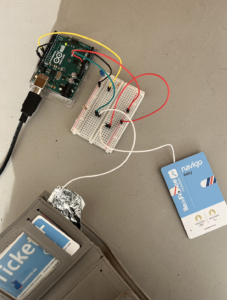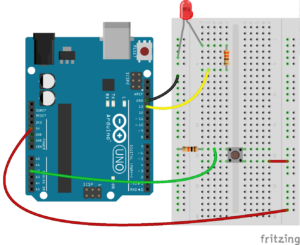Concept
When thinking about this project, I wanted to solve a problem that I constantly deal with. I often bring a different bag or wallet everyday, meaning I have to move all my cards and items to the other bag. However, whether it’s my credit card, metro card, or student ID, I always realize too late that I left something in my other bag and it’s frustrating to get to the subway and not have my metro card or to be at a café and realize my credit card is missing.
So, to fix this, I created a simple switch that tells me if my card is in my wallet. The idea is straightforward, if the card is inside, the circuit is complete, and the LED lights up. If the card is missing, the circuit remains open, and the LED stays off, reminding me to grab it from the other bag before I leave.
Here is a quick demo: IMG_5445
Implementation
To build the circuit, I mainly based it off of the switch circuit we went over in class, however instead of the button I used two wires, one connected to my wallet and the other to my metro card. I then placed a thin conductive strip of aluminum foil inside my wallet as well as on the metro card to make sure that when I insert the card it completes the circuit, turning on the LED. This way, I can quickly check if I have everything just by looking at the light, no need to rummage through my bag at the last second.
Below is the code I used:
int wireTouch = A2;
void setup() {
pinMode(11, OUTPUT);
pinMode(wireTouch, INPUT); // Button input
Serial.begin(9600);
}
void loop() {
int touchState = digitalRead(wireTouch);
Serial.println(touchState);
delay(1);
if (touchState == HIGH) {
digitalWrite(11, HIGH); // Turn LED ON if wires touch
} else {
digitalWrite(11, LOW); // Turn LED OFF if wires don't touch
}
}
Reflection
I think building this project was a fun and practical way to apply the switch circuit we learned in class to a real-life problem. I am pretty happy with the result as the circuit worked as expected, when the card was inside the wallet, the LED turned on, and when it was missing, the light stayed off. However, one challenge I faced was ensuring the conductive strips inside the wallet aligned properly with the card. At first, the connection wasn’t always reliable, and the LED flickered. I had to adjust the placement and use stronger adhesive to keep the strips in place.
In terms of improvements and additional elements, I could maybe add an LCD, so instead of just the LED turning on or off, an LCD display could show a message like “Card Present” or “Card Missing,” which would provide a clearer and more informative response. A sound alert could also be useful, I could add a small buzzer so that it gives a short beep when the card is missing or inserted, providing a more immediate and noticeable notification.


